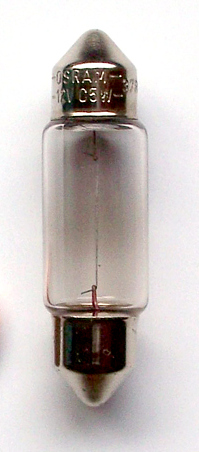Festoon lamp


A festoon lamp (often referred to as a festoon for short in the electronics sector ) is a cylindrical , electrical lamp , the two contacts of which are attached to the two opposite ends and require a corresponding lamp socket . In addition to the festoon lamps provided with a filament, whose functional principle is similar to that of the incandescent lamp , there are now also festoon lamps with LEDs .
Areas of application
Festoon lamps are mainly used to illuminate small displays, indicator lamps on devices, doorbell signs and for vehicle lighting. They were occasionally used for room lighting until the 1930s. The festoon lamps used in lights on motor vehicles (license plate lights, older tail lights) must be type-approved in Germany. They must either have an ECE approval mark or a national approval mark (K mark). Festoon lamps for interior lighting in motor vehicles do not have to be type approved.
Since the end of the Second World War, room lighting with festoon lamps has increasingly been replaced by fluorescent lamps . Only the S19 festoon, available in clear, matt and semi -mirrored versions, was able to hold up into the 1970s, for example in bathroom mirror lights, and also the somewhat smaller S15 festoon as a display case lighting.
Festoon lamps are also used in the field of electroacoustics and public address technology. In addition to PTC elements, they are used here as loudspeaker protection; They are installed as a series resistor on the crossover or directly on the loudspeaker phase terminal. With excessive load from the loudspeaker, the internal resistance of the festoons increases. If the current increases even further, they slowly begin to glow; if the load continues to increase until it burns out and thus mutes the loudspeaker concerned. The compensation takes place through energy conversion into heat and light energy. If you need strong protective functions (e.g. for two-way systems from 250 W), several festoons must be connected in parallel. As a rule, the degree of distortion that occurs when using festoons for PA / sound reinforcement tasks is justifiable. For the hi-fi sector, PTC elements (temperature-dependent resistance) are more recommended. In addition to festoon and PTC use, inexpensive products now also include LEDs or small incandescent lamps.
In the antenna input of radio receivers (for example in the EKD 300), festoon lamps are used as a fuse to protect against lightning strikes in the antenna, among other things.
The different designs and types of power are usually characterized by the ILCOS lamp designation system and are described in more detail there.
See also
Individual evidence
- ↑ Examples can be found in the technical report on IEC 1231 ( Memento of the original of February 22, 2012 in the Internet Archive ) Info: The archive link was automatically inserted and not yet checked. Please check the original and archive link according to the instructions and then remove this notice. of the ZVEI
